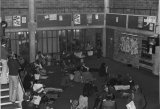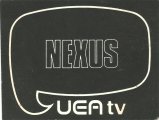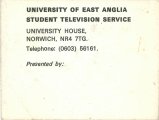Nexus TV - in the 1970s
Originally written 17th Feb 1993…
Nexus TV is the student television service of the University of East Anglia.
In the begining.
It came into being around the time that the University Audio Visual Centre opened, that is, on the 27th November 1969. At this time the Director of the A.V.C., Malcolm Freguard was being pestered by long haired students from the UEASU film unit, who wished to 'use television to make films'. Malcolm really fostered the idea of a student television society in self defence.
The leading lights in the society at this time were Roger Penfold, along with 'Fergus', (who went into commercial television), and 'that chap Evans', and ex film unit man. Malcolm suggested the name 'Nexus' - other ideas were 'Studio East' and 'Studio Four'. (At that time Anglia TV had three studios - Studio 4 was also, however, the name of a student frequented folk club at the back of Anglia TV).
Early Names.
It was really in 1969 - 70 that Nexus began to seriously become alive, and names from this period would include Andy Gambol, a Maths and Physics post grad, who was editor in 1970/71, Sally Boroughs, who married a lecturer in EAS and later moved to the USA, Gaynor Jones, who went into the BBC, and Elaine ?, who also went into the Beeb as a PA.
Originally programmes were not produced on a regular basis but Monday nights would see Nexus types emerging from their office in the basement of Arts 1 to congregate in the AVC studio, under the library building.
There a few hours would be spent under the guidance of the Chief Engineer, Wally Tyack, learning about the monochrome cameras and vtrs and producing a few programmes.
The irregular output of these sessions would be shown in lecture theatre 3 or 4, in the Village, (where the University started) and at Horsham, a student residence some four miles away. Latter the lecture theatre showings were dropped and programmes were shown in Arts 1, Floor 2 common room, which at that time, (1970-71), was a social centre. The end of 1971 saw the curtailment of the Village showings, and in 1972 Horsham was also axed, in both cases due to low viewing figures.
Besides the large AVC studio a few programmes were made in the simple monochrome studio in the Biology building, which had a single camera and rostrum stand.
1971.
1971 saw Nexus make its first investment in television hardware when it purchased a Sony ACE 2100 1/2" b&w open reel vtr and a 26" Decca b&w monitor. This was kept in Arts 01.21, which was Nexus's first full time office. Roger Penfold, the Editor in 1970 left to go to the BBC and Mark Taplin and Jerome Gibson took over in 1971. Both these enterprising Editors ended up in the BBC as well, Mark being a script writer who later went free-lance and Jerome on the Production side. Another name from this period was Graham Steele, who was one of the first technical people Nexus attracted.
Around this time a once a week current affairs programme format was arrived at, with it being recorded on Monday evenings in the AVC and shown on Tuesdays in the Arts Common Room.
1971 also saw the arrival of the AVC's ex Harlech TV OB van, and although not used for OBs it did provide additional facilities, as did a new VEL mixer/FX unit and EMI sound desk. Nexus had great fun using these new broadcast 'toys' !
1972
In 1972 Nexus was evicted from 01.21 in the Arts block and took up a temporary residence in Norfolk Terrace 'A' block, in a space just vacated by the Medical Centre, and later used by 'Nightline' (the student 'Samaritan' group. As an incentive to 'smooth' the move the University was persuaded to donate 680GBP to Nexus to purchase an Akai VT 110 1/4" b&w 'backpack' vtr and camera. This device gave endless problems and was sold in 1975 for 250GBP after which it worked perfectly !
Money
The first of many grants from the UEASU enabled Nexus to to buy a Sony off-air monitor.
1971 saw the beginnings of a long term strategy which brought about the change of Nexus from a 'club' into a fully functioning TV station with a powerful political say in UEASU affairs. David Matthewson began an interest in Nexus which was to last some 7 years, and in 1972 he became Nexus Treasurer and Engineer, working with the new Editor, John Getgood. John left UEA two years letter to go to BBC Radio Stoke and then onto BBC TV Centre in London.
University House
Under the new strategy Nexus first acquired a room in the newly completed University House, (1.18), which acted as office, studio and control room for almost a year. During this time the Decca monitor was permanently installed in the Foyer and lines soon laid to connect the monitor to room 1.18. This meant that for the first time Nexus could transmit programmes at any time, rather than during fixed sessions.
After some devious politics, Room 1.31 was acquired by Nexus and linked to 1.18 by an assortment of wires and cables. David Matthewson and Mike Wade became active in the UEASU Finance committee and shortly after a most generous grant was made to Nexus to purchase a considerable amount of television hardware. It was this grant which acted as the seed funding for Nexus to become a true Television Station.
The purchase included two Sony b&w cameras, VTRs, numerous monitors, a vision mixer and effects unit and an audio desk and record player.
The increase equipment was rapidly followed by an explosion of programmes, soon standardising in two news broadcasts a week and a new programme at least every day. A few attempts were made to rationalise the wiring but it was in the summer of 1974 that the first control desk was made by David Matthewson which incorporated full sound and vision switching. Metal cable trays were installed to tidy things up, a monitor was installed in the down stairs hamburger bar of University House and the TV sets in the television rooms were connected, (illegally!) to Nexus.
Mid-night drilling !
A number of nights were spent in clandestine drilling with a Kango hammer through the floor of University House to enable camera points to be installed in the Main Hall. This allowed the recording of concerts and other large events.
The years of 1974 and 1975 saw the incomparable Adam Wide as Nexus Editor and understandably, things took a turn for the bizarre - in the best possible way !. Any further description of Adam would be inadequate.
In 1975 and 76 Richard Hartt became Nexus Editor, one of the youngest students to do so. Under his Editorship Nexus consolidated its position as a voice of influence in the University and many of what were to become regular Nexus programmes were established.
Sounds Peculiar
The excellent 'Sounds Peculiar' pop music programme produced by Eddie Goodridge and Arthur Blick - with help from Arthur's lady, Neelam, was one of the most professional productions to emerge from Nexus.
'Contact'. a current affairs programme was started by Jim Bodgner and continued by Tom and Jermey ( who's father was then Bishop of Sheffield !), and rapidly became one of Nexus's most controversial programmes.
A Sports Department was also established producing a regular series of sports reports under the title of 'Score'.
On the the technical side
<2021 – seems I never finished this….. >


